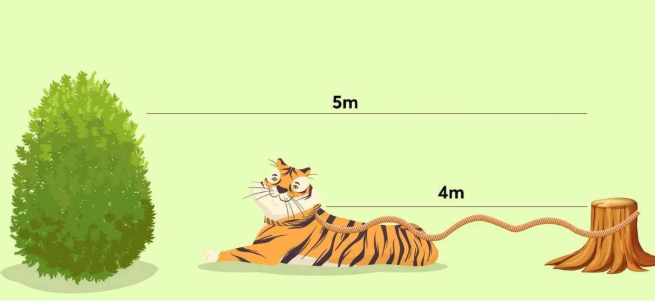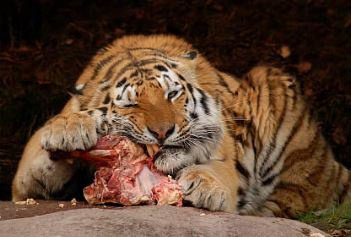Unveiling the Answer: How the Tiger Eats the Grass
Riddles have a special way of sparking curiosity. They challenge our thinking, twist our assumptions, and sometimes trick us into overcomplicating simple problems. One particular riddle about a tiger tied to a tree and a patch of grass has puzzled many. On the surface, it seems like a question of distance and strategy, but the real answer is surprisingly simple. In this article, we’ll break it down, uncover common misconceptions, and reveal the logical solution.
Introduction to the Riddle
Imagine a tiger tied to a tree with a 4-meter-long rope. A lush patch of grass lies 5 meters away from the tree. The question posed is simple: How does the tiger eat the grass? At first, this seems like a riddle of distance and strategy—how can the tiger reach the grass if it is 1 meter beyond its reach?
At a surface level, this riddle may seem to be about figuring out how to bridge the 1-meter gap between the tiger and the grass. However, this challenge isn’t what it seems at first glance. Before jumping to conclusions, let’s take a closer look at how this riddle works and why so many people struggle to solve it.

Common Misconceptions
Many people get caught up in the details of the riddle, overcomplicating the situation with assumptions and misunderstandings. Let’s explore the common misconceptions that people have when faced with this riddle.
Overthinking the Rope’s Length
One of the first details mentioned is the 4-meter-long rope, which immediately draws attention. Many assume that the solution involves the tiger stretching the rope, breaking it, or figuring out a way to extend its reach. This assumption is misleading because it focuses on logistics instead of the tiger’s behavior and nature. The rope, while mentioned, is just a distraction in this riddle.
Assuming the Tiger Eats Grass
Another common pitfall is assuming that the tiger actually wants to eat the grass. The riddle subtly encourages this misconception. After all, if a tiger is near grass, why wouldn’t it want to eat it? However, this assumption overlooks a key detail: tigers are obligate carnivores. They require meat, not grass, for nourishment.
Overcomplicating the Scenario
Some people come up with complex solutions, such as the tiger pulling the tree or finding a way to bend the rope’s path. These creative ideas may seem plausible, but they miss the simplicity of the riddle. The real solution lies in understanding the tiger’s nature, not in engineering complex solutions to the logistical problem.
Step-by-Step Breakdown: Solving the Riddle
Now that we’ve examined the misconceptions, let’s break down the riddle logically and work toward the solution. The riddle seems complex at first, but by approaching it step by step, we can uncover the simple answer.
Step 1: Analyze the Situation
The riddle presents a situation where a tiger is tied to a tree and a patch of grass is 5 meters away. At first glance, it seems that the tiger cannot reach the grass because the rope is only 4 meters long, and the grass is 5 meters away. This would make us focus on how to overcome this 1-meter gap.
Step 2: Question the Assumptions
Before diving deeper into calculations or logistics, we must ask the critical question: Does the tiger even want to eat the grass? The assumption that the tiger is trying to eat the grass is where most people go wrong. Tigers are carnivores, which means they eat meat, not grass. While it’s true that they might occasionally chew on grass for digestive reasons, it’s not their primary food source.
Step 3: Arrive at the Logical Answer
The simple solution to the riddle is that the tiger does not eat the grass because it does not want to. The question itself is a trick, designed to distract us with irrelevant details like the rope’s length, the tiger’s position, and the distance between the tiger and the grass. The real answer lies in understanding that a tiger’s natural diet does not include grass.

Why This Riddle Is So Effective
This riddle is effective because it exploits a common human tendency: the overcomplication of simple problems. By presenting seemingly important details like the rope and distance, the riddle tricks us into thinking about logistics and physical constraints. The real answer, however, challenges our assumptions and reminds us that the simplest solution is often the right one.
What This Riddle Teaches Us
Riddles are not just fun—they are also excellent tools for sharpening our thinking. Here are some valuable lessons we can learn from this riddle:
Question the Premise
One of the key takeaways from this riddle is the importance of questioning the premise. Don’t take every detail at face value. In this case, the assumption that the tiger wanted to eat the grass led us down the wrong path. Always ask yourself if the assumptions presented in the problem are valid.
Simplify, Don’t Overthink
Riddles like this show us that many problems have straightforward solutions. When faced with a challenge, don’t immediately start overcomplicating things. Often, the simplest answer is the most accurate one.
Consider the Context
In this riddle, understanding the context of the tiger’s diet was the key to finding the answer. Always take a holistic view of the problem and consider all aspects, including the nature of the elements involved.
How Did You Do?
Now that you know the answer, take a moment to reflect on your initial guess. Did you focus on the rope’s length or the tiger’s position? Or did you catch on to the fact that tigers don’t eat grass? It’s fascinating to see how different minds approach the same question in unique ways. The riddle serves as a reminder of how our thinking patterns can shape the way we solve problems.
Share the Riddle
Now that you understand the solution, challenge your friends with this riddle and see how they solve it. The fun isn’t just in the answer—it’s in the journey of figuring it out and the discussions it sparks. It’s always interesting to see how others approach a puzzle and what assumptions they make along the way.
The Joy of Simple Solutions
This riddle about the tiger and the grass is more than just a brainteaser. It’s a reminder of the power of simplicity. In our everyday lives, we often face problems that seem complex, but the solution might be much simpler than we think. Sometimes, the most straightforward explanation is the right one, and the key to solving a problem is questioning assumptions, stepping back, and thinking critically.
The tiger doesn’t eat the grass, not because it’s too far or the rope is too short, but because it simply doesn’t want to. The answer was hiding in plain sight all along. The next time you encounter a tricky question, remember this riddle: Step back, simplify the problem, and think critically. You might be surprised at how often the simplest answer is the right one.
Share this content:









Post Comment